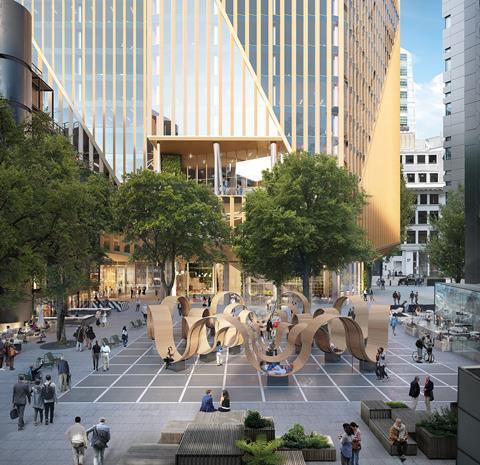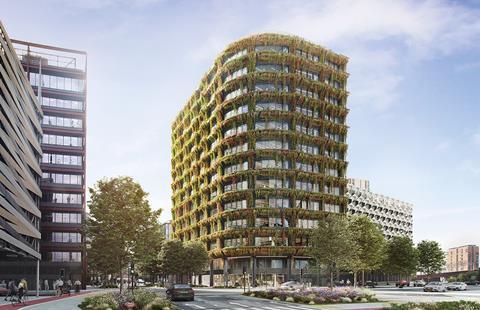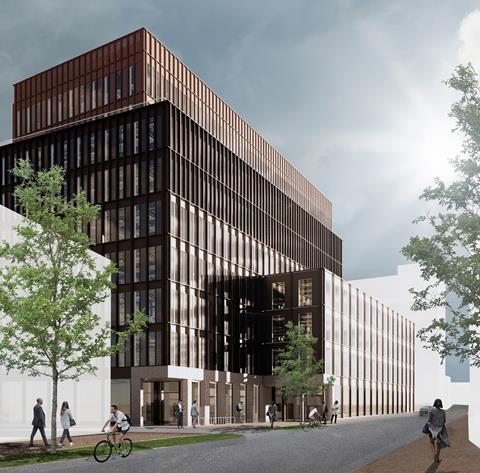UK offices could well become the standard-bearers for innovative carbon-cutting practices – but to make that happen, the industry first needs to shake up its approach. Aecom’s Brian Smith and David Thornley explain what needs to change, and provide a cost breakdown of a typical low carbon office scheme
01 / Introduction
The UK construction industry is facing a watershed moment. While reducing carbon has been on the agenda for years, the goal of achieving net zero is now gaining unstoppable momentum. Quality, cost and time were once the three essential factors to manage in order to successfully deliver a project: carbon has now been added as a fourth.
The UK leads the world in carbon-cutting commitments: as a nation it has a legally binding deadline for achieving net zero emissions by 2050. In April 2021 another target was introduced, as the government legislated to cut emissions by 78% from 1990 levels by 2035.
Meanwhile prime London office tenants, developers, real estate investors and their shareholders are driven by their own ambitious environmental, social and governance (ESG) agendas. Corporations and institutions are increasingly opting for even more ambitious targets than those of the government, with 2025 and 2030 net zero deadlines now commonplace.
To reach these targets, new offices being designed today must be net zero. But with few completed net zero buildings to provide a template, it is a challenge to balance carbon targets against the need to achieve commercial viability. Developers, consultants, the construction sector and the eventual tenants of new office buildings are being forced to reassess their priorities to integrate environmental requirements.
02 / Current situation in the sector
The carbon output of any new building is vast. The materials and labour, energy and natural resources required to deliver a building mean it is not technically feasible to reduce to zero the carbon associated with constructing and operating an office in the short to medium term, if ever. Finding effective ways to measure transparently, reduce rapidly, and benchmark carbon output is therefore essential; institutions including the RIBA, the London Energy Transformation Initiative and the UK Green Building Council (UKGBC), as well as individual consultants such as Aecom, have all developed systems and metrics for achieving net zero.
This means a standard definition of a net zero building is still up for debate. However, the UKGBC’s approach is gaining widespread acceptance. Its definition states net zero is “when the amount of carbon emissions associated with a building’s product and construction stages up to practical completion is zero or negative”. This is achieved through offsetting carbon, or via the net export of renewable energy generated on site. Once a building is up and running, operational net zero carbon is defined by the UKGBC as “when the amount of carbon emissions associated with the building’s operational energy on an annual basis is zero or negative”.
Reducing embodied carbon is the biggest challenge.
Good progress has been made with reducing operational carbon in office buildings. This is thanks to more efficient components, more informed and carbon-conscious building users, the shift from gas to electricity, and the broader decarbonisation of the UK’s national grid and power sources. Next steps in reducing operational carbon include establishing consistent measuring benchmarks and standards, and making standard such design features as all-electric buildings, air-source heat pumps, on-site energy storage, and on-site renewable energy sources such as solar photovoltaics.

As operational carbon reduces, embodied carbon is set to account for 75% of a building’s carbon within the next decade and is where design teams and developers now need to focus. The target metrics for embodied carbon will get progressively lower and harder to achieve over the next 10 years. Most embodied carbon is in the super- and substructure, which is where design solutions so far have been concentrated. However, reducing carbon in all elements, including the facades, MEP and fit-out, is now needed, as the targets can only be achieved through adding multiple marginal gains.
Interrogating the sustainability of building materials throughout their entire lifespan aligns with the circular economy concept, whereby waste is eliminated through the ongoing reuse and recycling of materials. This model is growing in stature and has increasing support from the government.
For example, the New London Plan 2021 demands that the entire lifecycle of a building be considered, from the carbon emissions created during construction to the recycling potential of the component parts left at the end of the building’s life.
In March 2021 the Environmental Audit Committee launched an inquiry into whether the government needs to assess and potentially legislate on the construction industry’s embodied carbon emissions, with calls for upcoming revised Building Regulations to regulate and limit embodied carbon.
03 / Solving design issues
While the embodied carbon in new construction cannot be cut to zero, it can be reduced through design and material choices. Remaining emissions can be offset by using renewable energy, either generated on site or else bought in – as most London commercial office buildings lack sufficient space to generate adequate renewable energy on site.
To achieve the targets set for the next 10 years requires conventional thinking to be challenged. Commercial developments have always been designed to maximise financial viability and returns. Specification levels have been chosen with the goal of attracting a wide range of occupiers rather than finding the most efficient engineering design.
With net zero targets now unavoidable, a balance between these factors must be found. If cutting carbon, waste and redundancy is now a core part of the design specification, the entire life of a building from construction to its eventual dismantling needs to be considered at the very outset. These complex considerations – and their solutions – can be boiled down to: build less, build clever, and build efficiently.
Build less – reframing refurbishment
As an industry, we need to get more comfortable reusing and reimagining existing structures and building components. Refurbishment is significantly less carbon-intensive, and retaining elements can lower the cost too.
We need to challenge if elements that traditionally are always replaced should instead be adapted and reused if there is meaningful design life left in them – for instance, elements of MEP installations on refurbishment projects or foundations and basements for new builds.
Designing for eventual reuse also supports circularity. Could the building later be adapted to a new purpose quickly and simply? How flexible is its design?
The ability to recycle content is also a key factor to consider when measuring embodied carbon. Could the steel be dismantled for reuse when it is finished with? Can recycled materials be sourced at the design stage of a scheme? These discussions need to take place at the very start of a project. Net zero is a day‑one consideration.
Build clever – choosing lower carbon materials
Choice is increasing, and the options on materials (and the embodied carbon within them) will change over the next decade to reflect the demands of the market as other industries address their own need to decarbonise in response to tighter regulations. Project teams need to consider factors such as the capacity of the supply chain, however. A holistic view of each material must be taken, considering its current market price and how locally it is made, as well as its durability and recyclability.
For instance, the use of cross-laminated timber (CLT) either for the complete structure or combined with concrete or steel is gaining prominence due to its lower embodied carbon, but CLT is not yet produced at scale in the UK and must be imported – which can increase its carbon output. There are also preconceptions about timber in the UK which may require a shift in the views of users, insurers and developers.

Manufacturers and suppliers of more traditional materials are also responding to the need for lower carbon options. Cement-free concrete alternatives are emerging, such as Cemfree and Earth-Friendly Concrete, which typically offer a significant saving in embodied carbon compared with standard concrete mixes. While there is a cost premium, the gap with traditional mixes will narrow as demand drives their development and their application in both in-situ and precast products.
Steelwork can be sourced from suppliers using electric arc furnaces with increased recycled content but requires a design to incorporate standard sections and integrate them early into the design.
Facades, given their relatively short design life, need to be designed with circular economy principles in mind so that they can be refurbished, replaced and recycled easily. The design intent needs to combine a solution that tackles both operational and embodied carbon, reducing heat loss through the envelope by using materials that have lower U-values and that require less energy to be produced and installed. Such strategies include reducing the amount of glazing relative to solid elements, increasing the amount of shading, and limiting specification enhancements such as low iron glazing that take large amounts of energy to manufacture.
The industry should also push for prefabricated systems to reduce waste and the optimise site installation process.
Advances are being made across the supply chain to increase the recycled content of glass and aluminium products used in cladding systems. As this approach becomes more widespread, such products will become more cost-effective.
Specifying mechanical, electrical and plumbing (MEP) plant also now needs to factor in circular economy principles. Forward-thinking suppliers are producing kit which is not self-contained, making it easier to replace components that can be upgraded for future-proofing, encouraging reuse rather than full replacement.
Build efficiently – migrating towards simpler buildings
In conjunction with opting for lower carbon materials and products, we need to move to simpler construction methods that use materials more efficiently, incorporating offsite manufacture and DfMA principles. Structures built this way can also be more easily taken down and reused – a key part of a low carbon strategy.
Building services provision can also be simplified. Designs that incorporate more passive systems, more natural ventilation, and fewer moving parts – essentially less kit – are rising in prominence. With MEP systems, we need to consider what the essentials are – what must be installed on day one – and what could be added later by the tenant if required. For example, a developer could enable a building with locations for plant and riser sizes but not install the plant or features unless requested. Such an approach could also mean priming a building for smart devices but not installing them. We need to re-examine the balance between what the landlord and tenant each provide. Landlords should not install anything a tenant may then strip out.
To make buildings more adaptable for a wider range of future uses, the traditional office specification levels must also be challenged. For example, do the power and lighting loads need to be at historic British Council for Offices standard levels? Can the temperature range within which the building operates be widened?
04 / Cost drivers
The technologies that can deliver lower carbon buildings are largely available and well understood, but commercial market dynamics must be taken into account. If there is insufficient market capacity to meet demand, this will drive up costs for certain trades and materials. The accelerating use of CLT in frames and of precast cladding are examples of where demand is expected to be greater than supply in the short to medium term.
There are carbon savings to be made by pursuing modern methods of construction (MMC). Precast, prefabricated and modular components, local materials sourcing, and offsite manufacture can all significantly reduce carbon output and reduce waste in terms of time, labour and materials. This route, given its reduced need for labour, may prove an inevitable one for the UK in the face of the nation’s ongoing skills gap. The reuse of materials – whether in the structure, foundations, MEP or all three – will save on costs too.

The cost level of a net zero office scheme is a direct consequence of the design solution developed. Opting for lower carbon products and materials as well as new technology does bring an initial cost premium compared with standard materials and processes, but reducing complexity – simplifying the engineering and specification to increase efficiency – will cut scheme costs, including through a shortening of the delivery programme.
05 / Looking forward
Many net zero carbon offices have been planned but few have been delivered. There is no one-size-fits-all solution to achieving net zero. In major cities such as London, where footprints are tight and anachronistic, each development’s carbon output must be assessed and solved on a project-by-project basis. Carbon must be considered at the start of the project for it to be integrated at the lowest cost, and for reduction efforts to be most effective. We must commit to continually reviewing schemes on a carbon as well as a cost metric, asking how we can drive efficiencies, draw on innovative new approaches, and deliver at pace.
Achieving net zero requires the industry to ask uncomfortable questions of itself and its processes. Building standards, regulations and codes need to be challenged to enable intelligent, cost-effective schemes supported by reliable benchmarking.
The UK’s net zero 2050 challenge is huge and can be reached only through a radical reimagining of how to plan, design, build, maintain and eventually dismantle built assets. Without immediate action, it cannot be done. The choices we collectively make and the buildings we create over the next five years will determine whether our industry is ultimately deemed a positive contributor or a detractor in meeting the UK’s ambitious climate change goals.
06 / About the cost model
This cost model is based on a new-build 10-storey commercial office building in a central London location. The parameters are set around a gross internal area (GIA) of 230,000ft² (21,368m²), including a single-storey basement, and with no abnormal site constraints beyond those typical of a central London site. Overall net to gross efficiency is assumed at 72% of the overall GIA, with an approximately 0.4 average wall‑to‑floor ratio.
The building uses a hybrid steel and CLT structure to reduce embodied carbon as well as build time, optimising the use of prefabrication and on-site labour. The lighter superstructure enables the building to adopt a reinforced concrete raft slab in lieu of a piled solution and it incorporates the use of Earth Friendly Concrete.
The core is constructed from reinforced concrete, left as an exposed finish to reduce the need for further materials. The external envelope is a precast system with recycled aggregate and uses a reduced glazed-to-solid ratio to increase shading and limit solar gain. Manually operated openable windows linked back to the building maintenance system with a traffic-light system allow passive ventilation. An allowance has also been included for photovoltaics to a proportion of the glazing.
Plant is located at roof level with a set-back ninth floor shared between offices, plant and a roof terrace. The building runs on an all‑electric system with the heating, ventilation and air conditioning based on a low-level ventilation system with passive chilled beams. The building targets BREEAM Outstanding, is smart-enabled and Wired Score Platinum.
The category A fit-out costs are assumed to be a contribution to the tenant, based on a design that utilises exposed visual grade CLT, therefore removing the need for a ceiling, as well as a recycled raised-access floor further reducing the embodied carbon.
Price levels are set at Q2 2021.
Estimated embodied carbon (A1 to A5) is in the range of 500kgCO2e/m² to 600kgCO2e/m².
Acknowledgments
The authors would like to acknowledge the contribution of Aecom colleagues Paul Mannion, William Bell and Richard van Breda towards the production of this article.
Download the cost model using the link below
Downloads
zero carbon office cost model
PDF, Size 55.1 kb



























No comments yet